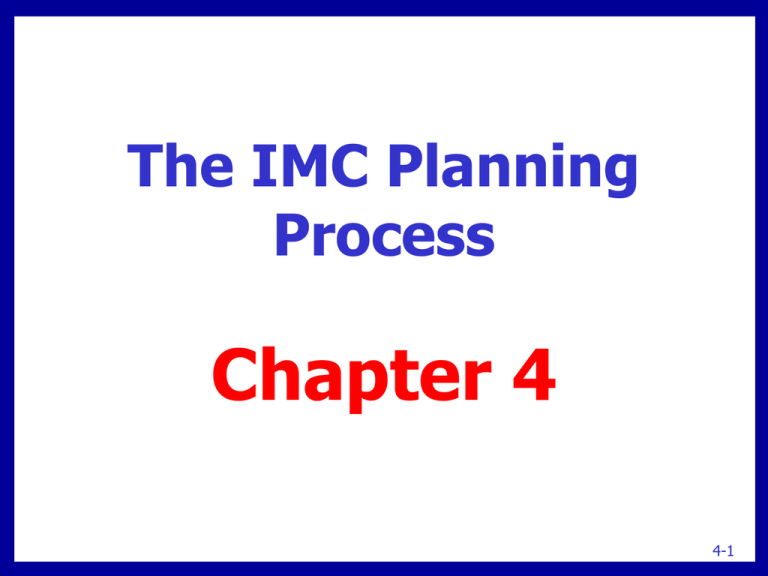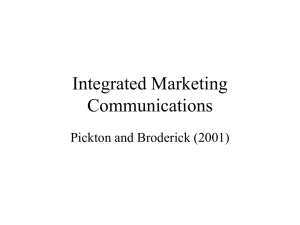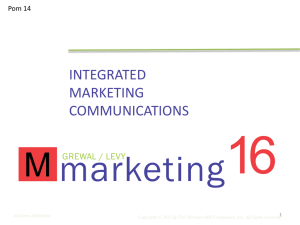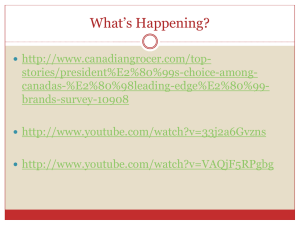Document
advertisement

The IMC Planning Process Chapter 4 4-1 Chapter Overview • • • • • • IMC planning Selecting markets Segments Targets Positioning strategies Communication objectives Budget IMC components 4-2 Communication Objectives • Develop awareness • Change beliefs and attitudes • Encourage loyalty • Build customer traffic • Enhance image • Increase market share/sales • Reinforce purchase decisions The IMC Planning Process Customers • • • • Current customers Former customers Potential new customers Competitors’ customers (Segmentation Variables) The IMC Planning Process Competitors Identify: • Who you will compete with • What are their communication strategies? Sources of info: • Secondary data • Other people • Primary research 4-5 The IMC Planning Process Communications Examine existing • Brand Positioning • Company communications • Industry communications Trade associations, etc. • Competitor communications Market Segmentation • Group with distinct characteristics. Homogeneous within • Differs from other segments and population. Heterogeneous across • Financially Viable - profitable • Reachable 4-7 Why Segment? • Identify company strengths and weaknesses. • Clarifies marketing objectives associated with specific target markets. • Links firm’s strategies and tactics to a specific target group Target Markets • • • • • Benefits sought. Methods of reaching markets. Appeals to each market. Needs not being met. Demographic and psychographic profile of each market. Defined by the markets’ needs and interests, not the company’s! 4-9 Opportunities • • • • Ignored Customers Benefits not articulated clearly Marketing approach Brand positioning Where is the competition “failing?” 4-10 Segmenting Consumer Markets • Demographics & Psychographics Generations Geographic Geodemographics • Benefits • Usage F ig. 4 . 2 Demographics - Gender Female consumers • Control 66% of spending ($12 trillion) • Involved in purchasing high-priced electronics (90%) • Buy and sell stocks (80%) • Household’s primary accountant (70%) Demographics - Gender BMW Motorcycle ad directed to men as the primary purchaser and women as the decision-making influencer – not the same message! Demographics - Age • Target specific age group • Combine with other demographic variables • Children as a group Spend $30 billion Influence $500 billion Click on speaker to play ad. Psychographic Segmentation • Describe consumers’ activities, interests, opinions (AIO) • Combine with demographics to develop target market variables Psychographics & Lifestyles (VALS II) • • • • • • • • Innovators – successful, sophisticated, upscale products Thinkers – educated, conservative, practical value Achievers – goal-oriented, conservative, career, family Experiencers – young, enthusiastic, impulsive, social Believers – conservative, conventional, traditional Strivers – trendy, fun-loving, peers important Makers – self-sufficient, respect authority Survivors – safety, security, focus on needs, price Psychographics & Technology • New Enthusiasts – cutting edge, eager, high incomes/education • • • • Hopefuls – cutting edge, lack financial means Faithful – not eager, but not averse Oldliners – not interested in new technologies Independents – higher incomes, do not value new technology • Surfers – ambivalent about new technology, cynical about business U.S. Consumer’s Segmented by Attitudes Toward Support of Green Marketing • True Blue Green (9%) – Strong environmental values, politically active. Heavy users of green products • Greenback Greens (6%) – Strong environmental values, not politically active. Heavy users of green products • Sprouts (31%) – Believe in theory, not in practice. Buy green only if equal to or superior to non-green products. • Grousers (19%) – Uneducated about environmental issues, cynical about their ability to effect change. Green products are too expensive and inferior. • Basic Browns (33%) – Don’t care about environmental issues or social issues. Source: Jill Meredith Ginsberg and Paul N. Bloom, “Choosing the Right Green Marketing Strategy,” MIT Sloan Management Review, Vol. 46, No. 1 (Fall 2004), pp. 79-84. 13-18 Demographic & Psychographic Male Teen Groups • Young metrosexuals – top 25%, outward appearance • • • • • Big man on campus Technosapians Red-blooded boys Tuned inward Under construction Demographic & Psychographic Female Teen Groups • Jockettes – top 25%, enjoy sports, active lifestyle • • • • In-style socialites Most likely to succeed Style meets thrift Traditionalists Generation Segmentation Segment Generation Y Generation X Younger boomers Older boomers Seniors Year of Characteristics Birth 1978-1992 Clothes, autos, college, televisions, stereos 1965-1977 Focus family and children 1954-1964 Focus family and home 1945-1953 Upgrade home, children’s education, luxury items Up to 1945 Fixed income, health care Geodemographic Segmentation • Combines Demographic census data Geographic information Psychographic information • Potential Rating Index by Zip Marketing (PRIZM) 62 market segments • Neighborhood Similarities B-to-B Segmentation • • • • • Industry (NAICS/SIC code) Size of business Geographic location Product usage Customer value 4-23 Information Sources The North American Industry Classification System (NAICS) Http://www.industrialwhoswho.com/company/naics.cgi Standard Industrial Classification (SIC) Http://www.industrialwhoswho.com/company/sic.cgi The Industrial Who’s Who Web Site Http://www.industrialwhoswho.com Product Positioning • Perception In mind of consumers Relative to competition • Created by factors such as Product quality Prices Distribution Image Marketing communications 4-25 A BtB advertisement positioned by the product’s attributes: the brightness of the Sony projector. An advertisement by Stetson positioned by cultural symbols. IMC Budget • Budgets based on communication objectives marketing objectives • Unrealistic assumption to assume direct relationship between advertising and sales Factors Impacting Relationship Between Promotions and Sales • • • • • • Goal of promotion Threshold effects Carryover effects Wear out effects Decay effects Random events 4-28 Sales-Response Curve An unrealistic assumption about the relationship between sales and expenditures A Decay Effects Model 4-30 Communications Budgets • Percentage of sales • Meet-the-competition • What we can afford • Objective and task • Quantitative models 4-31 Promotion Budgets Trade Promotions 28% Consumer Promotions 28% Other Advertising 41% IMC PLAN BASICS I. Executive Summary – Followed by Table of Contents II. Integrated Marketing Communications Management III. Promotion Opportunity Analysis IV. Corporate Strategies V. IMC Objective 1 (e.g., Consumer Objectives) VI. IMC Objective 2 (e.g., Channel Objectives) VII. IMC Objective 3 (e.g., B2B Objectives . . . . ) VIII.Media Plan IX. Evaluation Criteria I. Executive Summary • The entire plan, abbreviated. • Placed Before Table of Contents • Provides a brief statement of problem, selected solutions, and justification • Reader can find additional details by locating topic in TOC, then go to the body of the report. II. Integrated Marketing Communications Management At the “corporate” level • IMC Objectives • IMC Budget • Agency Selection • Internet Web site III. Promotion Opportunity Analysis A. Communications Market Analysis B. Communications objectives C. Communications budget Establish early guidelines D. Develop/Prepare promotional strategies E. Develop tactical support III-A. Communications Market Analysis 1. Competitive Analysis 2. Opportunity Analysis 3. Target Market Analysis 4. Customer Analysis 5. Positioning Analysis IV. Corporate Strategies A. Corporate Image Strategy B. Brand Development Strategy C. Brand Positioning Strategy D. Distribution Strategy E. Business-to-Business Strategy F. Public Relations Strategy Segment Plans • • Budget IMC Methodologies • Advertising • Consumer Promotions • Trade Promotions • Personal Selling • Sponsorships • • • Database Programs Media Plan Evaluation Methodology Integrated Marketing Communications Plan – Structural Outline Outline #2-4 occur at the corporate level and apply to all markets. Some included items: Executive Summary Promotion Opportunity Analysis Corporate-Level Strategies IMC Management IMC Objective: Target Market 1 The entire plan is summarized into a brief and concise document that presents the major elements of the plan to executive management. •competitive analysis •segmentation analysis and strategy •target market selection •Selection of channels to reach targets •positioning strategy •Corporate Image •Brand Development and positioning •Promotion Mix Strategy (corporate & target) •Total budget •And so on . . . . IMC Objective Target Market 2 •Budget •IMC Methodologies • Advertising • Consumer Promotions • Trade Promotions • Personal Selling • Sponsorships •Database Programs •Media Plan •Evaluation Methodology IMC Objective Target Market 3 Mkt 4, 5, etc. Each target market receives an analysis that includes the items in the box at the left. This is repeated for every target market.






